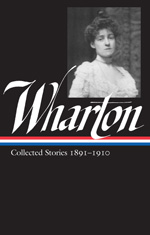From Edith Wharton: Collected Stories 1891–1910
Interesting Links “‘The Future Belonged to the Showy and the Promiscuous.’ How Edith Wharton Foresaw the 21st Century.” (Emily J. Orlando, Literary Hub)
“In Praise of Edith Wharton’s Beloved Antiheroine, Undine Spragg” (Sofia Coppola, Literary Hub)
Previous Story of the Week selections
• “The Pelican,” Edith Wharton
• “A Matter of Principle,” Charles W. Chesnutt
• “Her Letters,” Kate Chopin
• “Great Men’s Sons,” Booth Tarkington
Buy the book
 Edith Wharton: Collected Stories 1891–1910
Edith Wharton: Collected Stories 1891–1910Two novellas: The Touchstone and Sanctuary | 36 stories | 928 pages
List price: $40.00
Save 20%
Web store price: $31.50
Save $25 when you buy both volumes of Edith Wharton’s stories.
 |
| Portrait of a man with a letter, late nineteenth century, oil on canvas by an unknown (probably French) artist. Image courtesy of The Art of Antiquing, Round Pond, Maine. “‘Is this what you’d like to say to him?’ I asked her when the letter was done. . . . And she copied it out and signed her name to it, and sent it.” (from “His Father’s Son”) |
When R.W.B. Lewis published his biography of Wharton in 1975, he devoted an entire appendix to the topic and decided that, while impossible to disprove, the gossip was almost certainly false. “On balance,” he concluded, “there was definitely a rumor about Edith Wharton's illegitimacy, and it was a fairly tenacious one; but it did not originate with her or with anyone close to her in her childhood. It attracted Edith Wharton's attention during the first decade of the century, and she was sufficiently stirred to make some attempt at validating it.” Louis Auchincloss, in his short biography, found the doubts regarding Wharton’s paternity ridiculous and posited they were fueled by little more than a misguided, snobbish belief that the Jones lineage, with its “rarity of such intellectual achievement,” could not have produced an Edith Wharton. He added, “The theory seems to spring from the same kind of thinking that cannot conceive a Shakespeare born in Stratford.”
Although the identity of Edith Wharton’s biological father is no longer in doubt, what remains relevant is that, at some point, she learned about the rumors. Lewis believes that she might have first heard the gossip in the years prior to writing “His Father’s Son,” which appeared in Scribner’s Magazine in 1909. Because of its connection to questions of legitimacy, the story has always been of interest to her biographers, and Wharton seems to tackle the issue head on. Her story implies that support and encouragement from one’s parents, as well as their secret or untapped ambitions, can matter far more than social or intellectual heredity to the development of a child’s creativity and intelligence.
Readers have made much of the twist—or more accurately, twists—of the final section, which suggests the influence of O. Henry and other contemporary magazine writers who dominated the literary scene in the first decade of the twentieth century. Yet, in recent decades, numerous critics have pointed to various questions those plot turns seem to evoke: whether nature or nurture is more important to the development of the artist, whether a man can write convincingly as a woman (or vice versa), whether a text (or in this case, a series of letters) can reveal to the reader the gender of the writer, and how two readers can conjure two entirely contrary understandings from the same text.
Note: A Latmian night refers to a poetic tradition based on a Greek myth: Selene, the goddess of the Moon, descends to visit Endymion, a handsome shepherd of Mount Latmos, and chastely admires his beauty as he sleeps.
* * *
After his wife’s death Mason Grew took the momentous step of selling out his business and moving from Wingfield, Connecticut, to Brooklyn. . . . If you don't see the full selection below, click here (PDF) or click here (Google Docs) to read it—free!This selection may be photocopied and distributed for classroom or educational use.